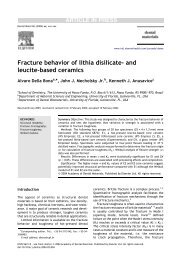Micro-tensile bond strength of adhesives bonded to class-I cavity ...
Micro-tensile bond strength of adhesives bonded to class-I cavity ...
Micro-tensile bond strength of adhesives bonded to class-I cavity ...
Create successful ePaper yourself
Turn your PDF publications into a flip-book with our unique Google optimized e-Paper software.
1002<br />
the specimens that survived specimen processing<br />
with an explicit note <strong>of</strong> the number <strong>of</strong> pre-testing<br />
failures.<br />
Study design<br />
All specimens were randomly divided in<strong>to</strong> nine groups<br />
(3 <strong>adhesives</strong>!3 experimental groups, Fig. 1) and<br />
subjected <strong>to</strong> a <strong>bond</strong>ing treatment strictly according<br />
<strong>to</strong> the respective manufacturer’s instructions<br />
(Table 1). After adhesive procedures, all teeth were<br />
s<strong>to</strong>red in water for 24 h at 37 8C. For each adhesive,<br />
three teeth were subjected <strong>to</strong> 20,000 thermal cycles<br />
(group 1: thermo-cycling/<strong>cavity</strong>), i.e. the res<strong>to</strong>red<br />
<strong>cavity</strong> was changed between two water baths <strong>of</strong> 5 and<br />
55 8C with a dwell time <strong>of</strong> 30 s at each temperature<br />
extreme (Thermocycler, Willytec, Munich,<br />
Germany). From six other teeth per adhesive, four<br />
mTBS specimens (per <strong>to</strong>oth) were prepared. Two <strong>of</strong><br />
these specimens were also subjected <strong>to</strong> the same<br />
thermo-cycling regimen (group 2: thermo-cycling/<br />
stick). The other half <strong>of</strong> these specimens were s<strong>to</strong>red<br />
for 20 days, the time needed for the thermo-cycling<br />
procedure, in 100% humidity <strong>to</strong> serve as control<br />
(group 3: control).<br />
Statistical analysis<br />
The results were analyzed at a significance level <strong>of</strong><br />
0.05 using a two-way ANOVA and post hoc Tukey–<br />
Kramer multiple comparisons. All statistics were<br />
performed using the statistical s<strong>of</strong>tware package<br />
(StatS<strong>of</strong>t, Tulsa, OK, USA).<br />
Failure analysis<br />
The mode <strong>of</strong> failure was determined light-microscopically<br />
at a magnification <strong>of</strong> 50! using a<br />
stereomicroscope, and recorded as either ‘failure<br />
within dentin’, ‘interfacial failure’ or ‘failure<br />
within resin’.<br />
From each group, representative mTBS-specimens<br />
were processed for field-emission gun scanning<br />
electron microscopy (Feg-SEM, Philips XL30,<br />
Eindhoven, The Netherlands) using common electron<br />
microscopic specimen processing techniques<br />
including fixation, dehydration, chemical drying,<br />
and gold-sputter coating [12].<br />
Results<br />
The mean mTBS, SDs, the number <strong>of</strong> pre-testing<br />
failures (ptf) and the <strong>to</strong>tal number <strong>of</strong> specimens (n)<br />
are summarized per adhesive and experimental<br />
condition in Table 2, and graphically presented in<br />
box-whisker plots in Fig. 2. Thermo-cycling <strong>of</strong><br />
neither the mTBS specimens, nor the res<strong>to</strong>red<br />
cavities decreased the <strong>bond</strong> <strong>strength</strong> <strong>of</strong> the<br />
<strong>adhesives</strong> tested.<br />
Pre-testing failures were only recorded for the<br />
one-step self-etch adhesive (iBOND). All pre-testing<br />
failures occurred during specimen processing<br />
(mostly during preparation <strong>of</strong> the sticks with the<br />
diamond saw). No additional pre-testing failures<br />
were produced by thermo-cycling. Because <strong>of</strong> the<br />
high number <strong>of</strong> pre-testing failures, the data <strong>of</strong><br />
iBOND were excluded from the statistical analysis,<br />
as <strong>to</strong>o few valid data were available <strong>to</strong> perform an<br />
adequate analysis and thus <strong>to</strong> draw a valid<br />
conclusion regarding degradation <strong>of</strong> this adhesive.<br />
The two-way ANOVA analysis disclosed no significant<br />
difference in mTBS between OptiBond FL<br />
and Clearfil Protect Bond (pZ0.321), nor between<br />
the different experimental conditions (control,<br />
thermo-cycling/<strong>cavity</strong> and thermo-cycling/stick;<br />
pZ0.111). The <strong>bond</strong>ing effectiveness <strong>of</strong> the onestep<br />
self-etch adhesive tested, iBOND, was however<br />
already compromised at baseline, given the high<br />
number <strong>of</strong> pre-testing failures (Table 2).<br />
For none <strong>of</strong> the <strong>adhesives</strong>, were morphological<br />
changes induced by thermo-cycling observed using<br />
light-microscopy (Table 3) or Feg-SEM (Fig. 3–5) <strong>of</strong><br />
the fracture surfaces. For the one-step self-etch<br />
adhesive, most specimens failed within the resin<br />
(Table 3; Fig. 5). Especially in the areas that<br />
fractured very close (a few mm) <strong>to</strong> the interface,<br />
the resin appeared very porous, and at higher<br />
magnifications many porosities could be noticed.<br />
The porosity amount and density was clearly higher<br />
in the area near <strong>to</strong> the interface with dentin, but<br />
also in the adhesive resin itself, some larger<br />
porosities could be observed (Fig. 5).<br />
Table 2 mTBS <strong>to</strong> dentin.<br />
mTBS (SD)<br />
ptf/n<br />
Control no<br />
thermocycling<br />
Thermo-cycling (20,000<br />
cycles)<br />
Cavity Stick<br />
OptiBond FL 20.0 (3.6) 27.0 (11.5) 18.3 (9.8)<br />
0/11 0/11 0/13<br />
Protect<br />
Bond<br />
J. De Munck et al.<br />
23.8 (8.3) 24.7 (9.9) 23.1 (7.5)<br />
0/11 0/14 0/12<br />
iBOND 14.7 (11.9) 12.1 (4.9) 12.6 (3.8)<br />
6/9 8/12 11/20<br />
mTBS, micro-<strong>tensile</strong> <strong>bond</strong> <strong>strength</strong>, value in MPa; ptf, pretesting<br />
failure; n, <strong>to</strong>tal number <strong>of</strong> specimens; SD, standard<br />
deviation.
















